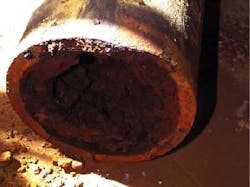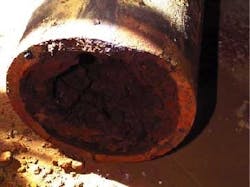By Albert J. Capuzzi, Catherine M. Spencer and Tiffany Tran
Red water represents a very serious aesthetic and consumer confidence problem for aging infrastructure systems in America's older cities. These water distribution systems were built primarily with unlined cast iron pipe over 100 to 150 years ago. Greater Boston, for example, has more than 50 percent unlined cast iron pipe, which represents approximately 3,000 miles, in its water transmission network.
Red or discolored water results from the release of iron from unlined cast iron water pipe. Because of the iron it carries, red water discolors plumbing fixtures, stains clothes in washing machines, and prevents cooking uses. It also generates taste and odor complaints and erodes customer confidence in the safety of the water.
Relining or replacing the distribution system piping will solve this problem, but is a massive undertaking. It is also very expensive and disruptive to the public, especially in America's larger, more congested cities, and can take years to complete.
Having this iron particle and red water generator in its system, the Massachusetts Water Resources Authority (MWRA) was concerned about making water quality changes to control another distribution system problem elevated lead levels at customer taps. Other water utilities had previously implemented lead corrosion control strategies with disastrous red water results. Hence, MWRA and Black & Veatch developed an applied research program to better understand the causes for red water and to develop effective means to control it while simultaneously reducing lead levels.
Finding optimum water quality conditions for lead and iron control was the only feasible cost-effective and near-term solution for red water. The chemistry of lead control is well understood and two treatment techniques have proven successful for lead solubility reduction. The first strategy is a high pH (greater than 9.0) treatment. The alternate strategy is application of orthophosphate within an optimal pH range of 7.2 to 7.8.
Unfortunately, the impact of such lead-reducing strategies on red water have been poorly understood. The goal of this project was to provide guidance to MWRA and other utilities on how to reduce red water through advanced management of water quality and operational practices while maintaining compliance with Lead and Copper regulations.
Innovative Approach
The project team developed a comprehensive experimental program that included laboratory compositional analyses and pilot studies that simulated real-world distribution system conditions. This project represents the first comprehensive scientific study to determine the causes of red water and develop effective control strategies to combat it.
First, the project team designed and built a pilot distribution system simulator using seven, 100-foot lengths of six-inch, 100-year-old pipe from the Boston Water and Sewer Commission (BWSC) network. Subconsultant Economic and Engineering Services Inc. of Bellevue, WA, designed the pilot facility to simulate real-world distribution systems and assisted in construction and startup. The pipes were excavated by BWSC and fabricated by MWRA into a multiple pipe rack pilot system.
By replicating the water conditions in the actual pipe network and simulating different treatment approaches in selected pipe racks, the pilot system was able to simulate MWRA's distribution system water quality. To mimic current treatment, all pipe racks received water that had been treated with sodium hypochlorite for disinfection, sodium bicarbonate for alkalinity adjustment, sodium hydroxide for pH increase to 7.8, and ammonia for chloramine formation as the secondary disinfectant. Treatment schemes evaluated included: effect of pre-ozonation on iron release; effect of further pH increase to 9.5 with concurrent alkalinity adjustment to 35 mg/L, i.e. increased buffer intensity; and addition of orthophosphate at 3 mg/L.
The comparison of water quality resulting from the treatment experiments allowed the project team to determine the factors that lead to iron release and to determine, validate, and confirm red water control theories.
To assist in the evaluation of these treatment experiments, Black &Veatch retained Vernon L. Snoeyink, Ph.D., Professor of Environmental Engineering at the University of Illinois at Urbana-Champaign. He performed the iron scale analysis using x-ray diffraction and scanning electron microscopy to determine the origin of iron in the water. In addition, Black & Veatch engaged Dr. Anne Camper, Assistant Professor at Montana State University and Research Team Leader in the Center for Biofilm Engineering, to conduct the biofilm analysis to better understand the microbiological component of iron scale and determine the bacterial regrowth following various control treatment strategies.
As part of the laboratory analyses, the team used x-ray diffraction and scanning electron microscopy to better understand the composition of the iron scales. Knowledge of scale composition and water quality changes within the pipe racks led to a better prediction of water quality behavior (iron release and resultant red water).
Specifically, the experiments demonstrated that:
- Iron scale consists of both reduced (Fe +2) and oxidized (Fe +3) states rather than only the oxidized state.
- Iron scale has a diverse microbiological component altering the scale.
- Much of the iron material is amorphous rather than crystalline.
Next, the project team applied for the first time the concept of buffer intensity to control red water. This discovery led to a critical control strategy: Increased buffer intensity stabilizes pH and leads to decreased iron release. The research also revealed that iron release can also be reduced with the addition of orthophosphate as long as buffer intensity is sufficient to maintain optimum pH for proper orthophosphate reactions with iron pipe surfaces.
Results
The pipe rack experiments have advanced the state of knowledge on red water both its causes and its control mechanisms. In summary, this program yielded the following optimal red water control strategies:
- Maintaining the optimum buffer intensity stabilizes the pH and reduces iron release.
- Adding orthophosphate significantly decreases the iron release rate.
- Increasing the dissolved oxygen reduces the iron release rate.
Based on the research result, Black & Veatch recommended that MWRA increase its pH to 9 and its alkalinity to 37 mg/l from 7.8 and 30 mg/l respectively in its water distribution system. This increased the buffer intensity and stabilized the pH. As a result, MWRA is achieving simultaneous red water and lead control.
Conclusion
The results of this study permitted MWRA to make water quality changes needed for lead control with confidence. MWRA implemented the recommendations of the study, increasing the buffering intensity to achieve better pH stability. This has enabled simultaneous control of red water, lead, and bacterial regrowth. As a result, lead levels have steadily decreased and red water levels have been controlled. This project has helped MWRA achieve two of its primary goals: protecting public health and increasing customer satisfaction.
From an economic standpoint, the benefits of controlling red water through optimized water quality conditions are staggering. MWRA's pipeline renewal and replacement program is expected to continue for 40 years at an estimated annual cost of $30 million. Water quality based improvements recommended in this study will cost MWRA $1,650,000 annually. Although these improvements do not eliminate the need for renewal and replacement of aged infrastructure, implementation of the recommendations will provide immediate water quality benefits for the entire system. Replacement programs can then be optimized based on pipe integrity issues.
The implications of this project extend well beyond MWRA. The control strategies provide water utilities that are experiencing red water problems, both domestically and globally, with scientifically based guidance for improving water quality.
About the Authors:Albert J. Capuzzi, P.E., is Project Manager at Black & Veatch. Catherine M. Spencer, P.E., is a Water Quality Specialist for Black & Veatch. Tiffany Tran, P.E., is Project Manager for the Massachusetts Water Resources Authority.




